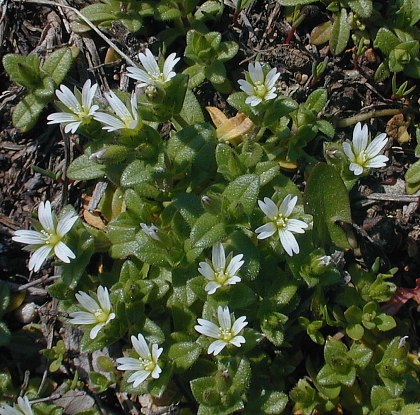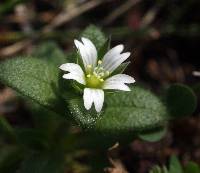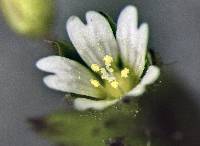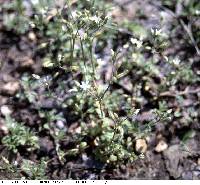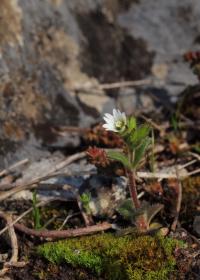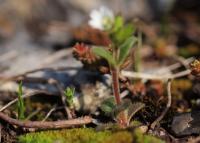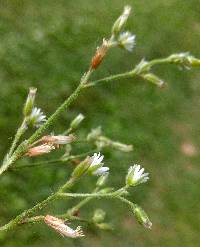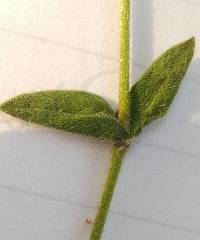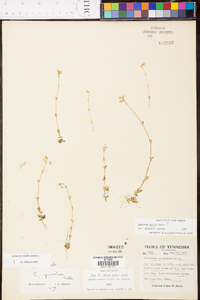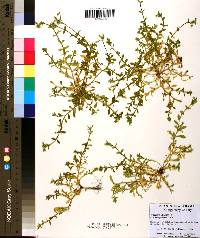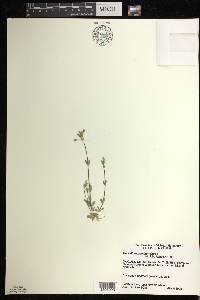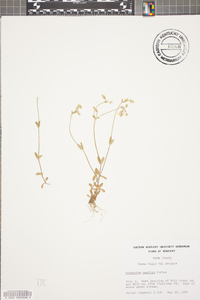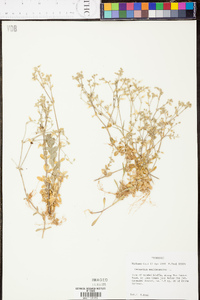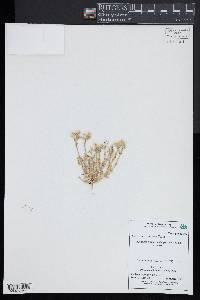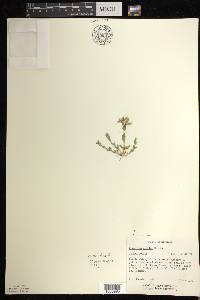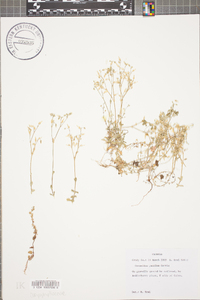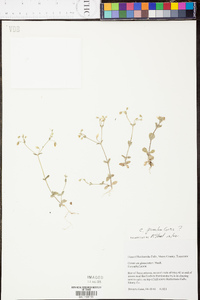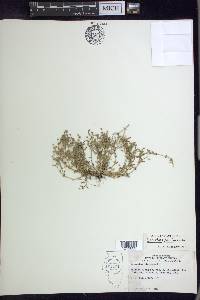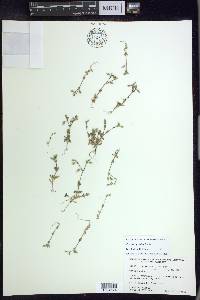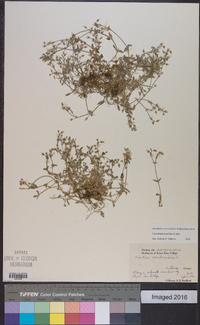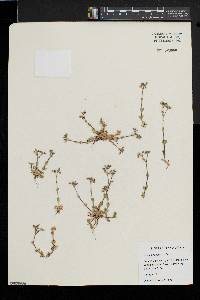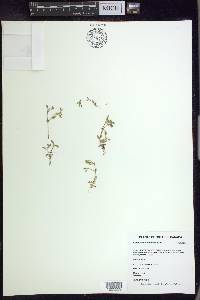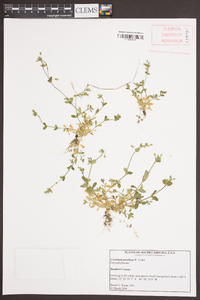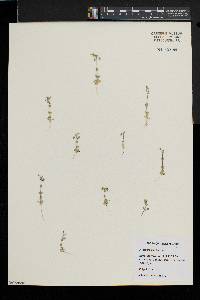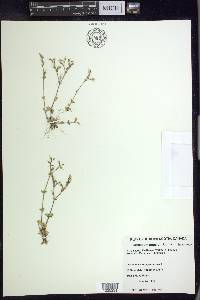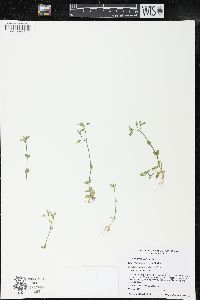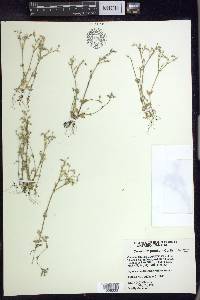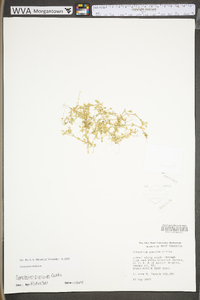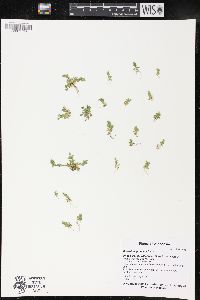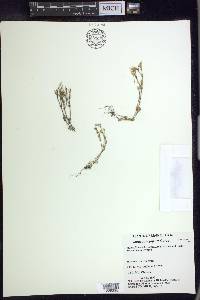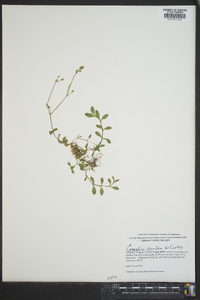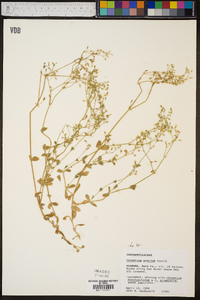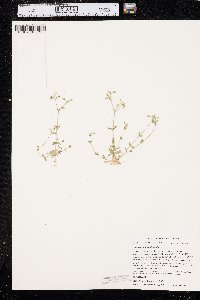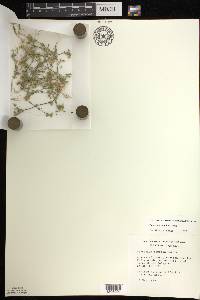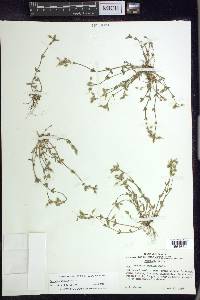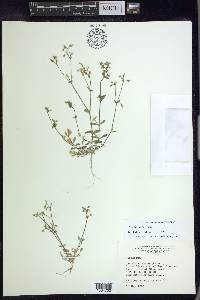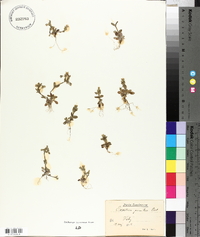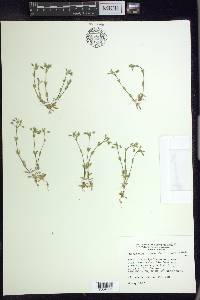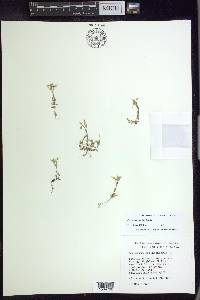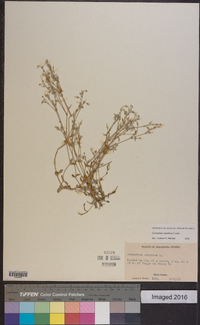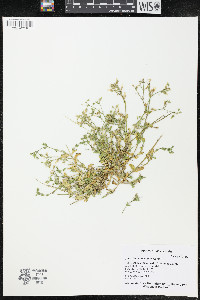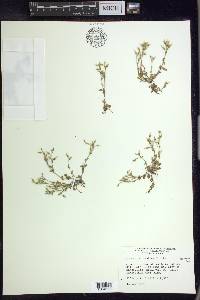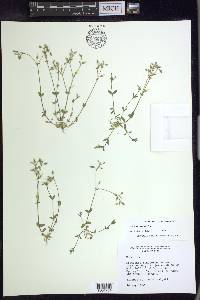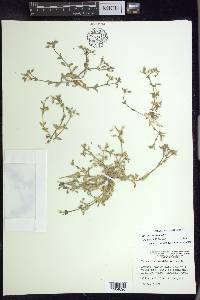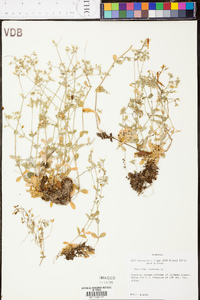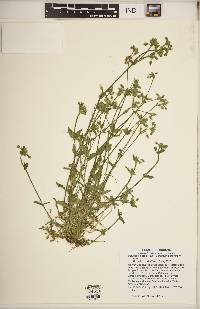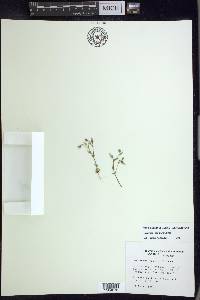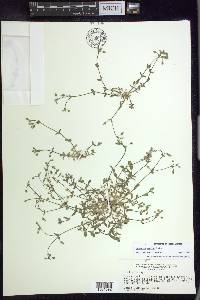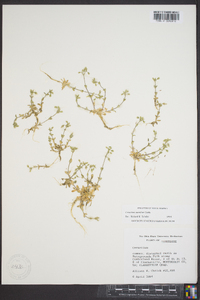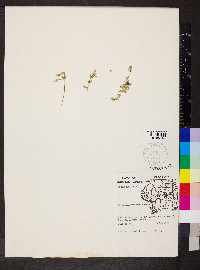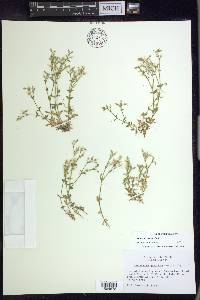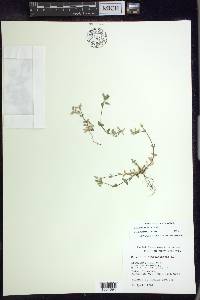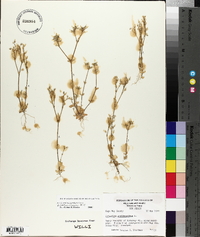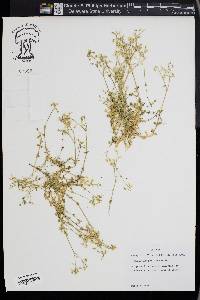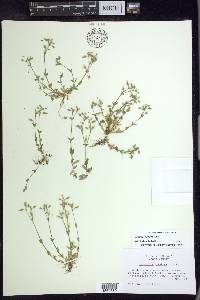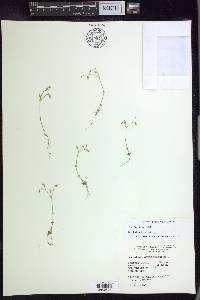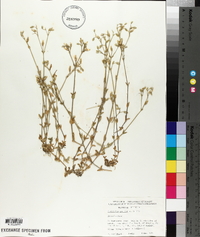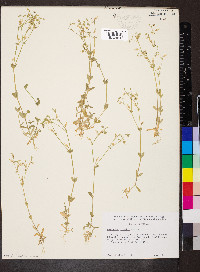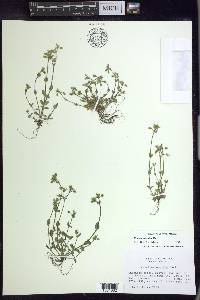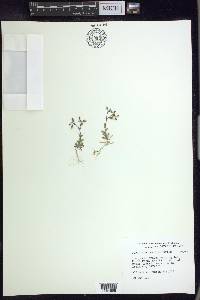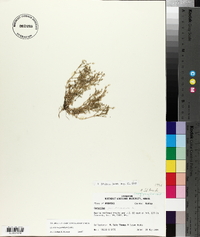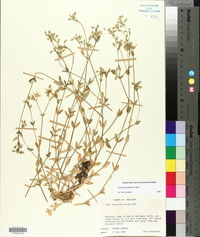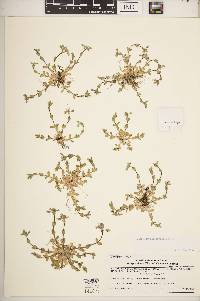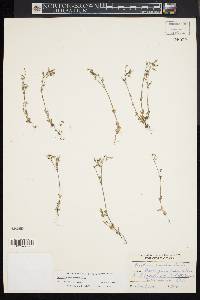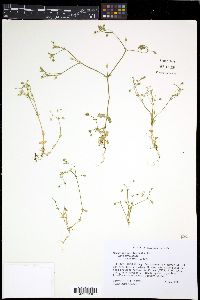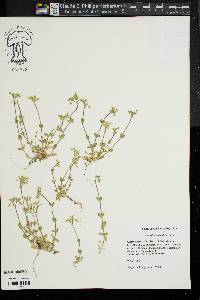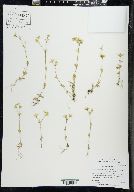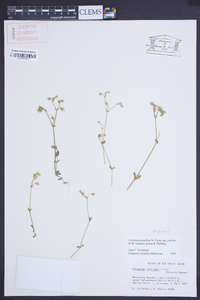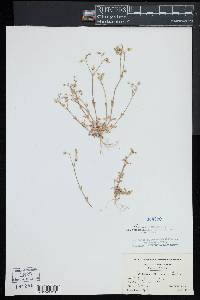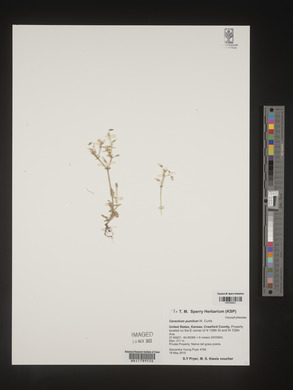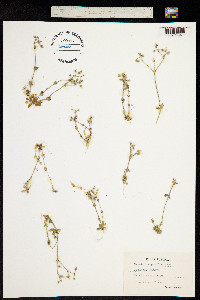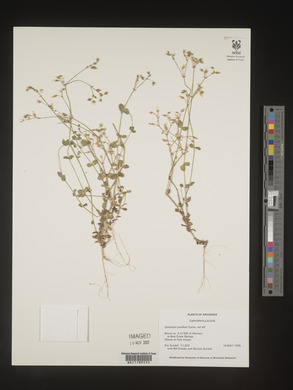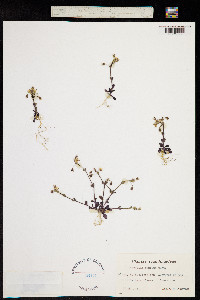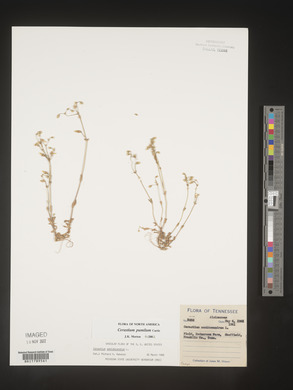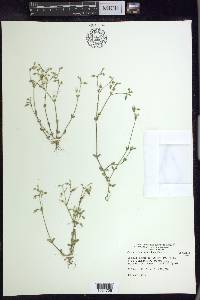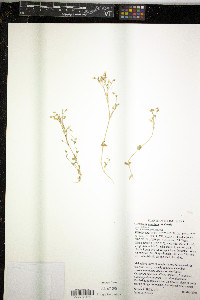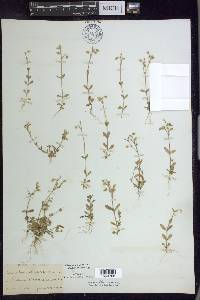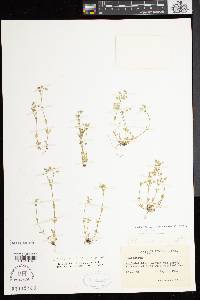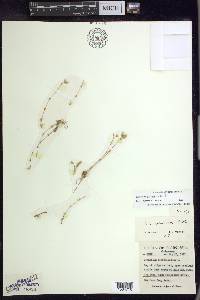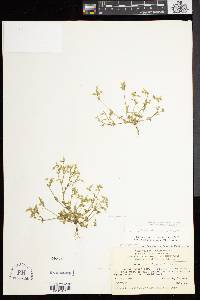Cerastium pumilum
|
|
|
|
Family: Caryophyllaceae
European Mouse-Ear Chickweed
|
Plants annual, with slender taproot. Stems erect or ascending, branching near base, 2-12 cm, covered with glandular and eglandular hairs; small axillary tufts of leaves usually absent. Leaves not marcescent, sessile; blade 5-15 × 3-6 mm, hairy; basal with blades oblanceolate, spatulate, petiolelike, apex obtuse; cauline with blades lanceolate, elliptic, or ovate, apex acute to obtuse. Inflorescences lax, 3-15-flowered (rarely more) cymes; bracts lanceolate: proximal usually foliaceous, distal smaller, usually with narrow, scarious margins and apex, glandular-pubescent. Pedicels erect, curved distally, 3-8(-10) mm, longer than capsule, glandular-pubescent. Flowers: sepals green, sometimes red tipped, oblong-lanceolate, 4-5 mm, margins narrow, apex acute, pubescent, hairs short, stiff, glandular, not projecting beyond scarious, glabrous apex; petals white or purple-tinged, with branching veins, oblanceolate, ca. 5 mm, ± equaling sepals, apex 2-fid for ca. 4 length; stamens 5; styles 5. Capsules narrowly cylindric, slightly curved upward, 6-9 mm, ca. 2 times as long as sepals; teeth 10, erect, margins convolute. Seeds dark brown, deltoid, 0.6-0.7 mm, tuberculate; testa not inflated. 2n = 72. Flowering spring. Dry, sandy, gravelly places on roadsides and arable land; 0-900 m; introduced; B.C., N.B., N.S., Ont.; Ala., Ark., Ga., Ill., Ind., Kans., Ky., Maine, Md., Mich., Miss., Mo., Nebr., N.J., N.C., Ohio, Okla., Oreg., Pa., S.C., Tenn., Tex., Va., Wash., W.Va.; Eurasia. North American material referred to here as Cerastium pumilum is very variable. At one extreme are plants resembling small annual forms of C. fontanum, with relatively short, broad capsules, petals slightly longer than the sepals, and sepals that are usually red at the tips. At the other extreme are plants with relatively long, narrow capsules resembling impoverished diffuse-inflorescenced C. glomeratum, with short petals and no red pigment. The latter are probably referable to C. pumilum subsp. glutinosum. B. Jonsell and T. Karlsson (2001+, vol. 2) treated C. glutinosum as a distinct species in Scandinavia, but the correlation of characters that they gave to distinguish C. glutinosum from C. pumilum does not occur in most North American material that I have examined. Hence, the recognition of a single species, possibly with two subspecies, as in Flora Europaea (T. G. Tutin et al. 1964-1980, vol. 1), appears to be more appropriate. The problem may arise from North American material having been introduced from several sources, whereas Scandinavian material may consist of two native genotypes that do not show the complete range of variation in the species. Cerastium pumilum can look like a small annual form of C. fontanum but differs in its smaller capsules and the characteristic rather short, glandular hairs on the sepals, bracts, and inflorescence. It can be separated from C. semidecandrum by the much narrower scarious margins of the sepals and bracts and by the branching veins in the petals, which tend to be slightly longer and more conspicuous than in C. semidecandrum. Some forms of C. glomeratum have a very open inflorescence and may be confused with C. pumilum, but C. glomeratum has ten stamens, a narrower capsule, all the bracts herbaceous, and long, eglandular hairs (often mixed with glandular ones) on the bracts and sepals.
Annual herb with a slender taproot 2 - 12 cm tall Stem: upright or ascending, branched near the base, with glandular and non-glandular hairs. Leaves: opposite, stalkless, 0.5 - 1.5 cm long, 3 - 6 mm wide, reverse lance-shaped to spatula-shaped (basal) or lance-shaped to egg-shaped (stem), hairy. Inflorescence: a lax cluster (cyme) of three to fifteen flowers subtended by glandular-hairy, lance-shaped bracts. The upper bracts have narrow, scarious (dry, thin, and membranous) margins. The lower bracts are all green. Flowers: white, sometimes tinged with purple. Stalk upright, 3 - 8 mm long, glandular-hairy. Stamens five. Styles five. Sepals: five, sometimes red-tipped, distinct, 4 - 5 mm long, oblong lance-shaped with a pointed tip, glandular-hairy. Petals: five, white, sometimes tinged with purple, about 5 mm long (more or less equaling the sepals), reverse lance-shaped, deeply notched, clawed, with branched veins. Fruit: a dehiscent capsule (opening by ten short, upright teeth), 6 - 9 mm long, longer than the sepals, narrowly cylindrical, slightly curved upward. Seeds numerous, dark brown, triangular, dorsally grooved. Similar species: Having some or all of the bracts with scarious margins (or at least the upper part of the bracts) helps to distinguish this species, Cerastium arvense, C. fontanum ssp. vulgare, and C. semidecandrum from most other Cerastium in the Chicago Region. Cerastium arvense differs by having petals that are usually more than 10 mm long. The perennial C. fontanum ssp. vulgare differs by having basal offshoots and ten stamens. Cerastium semidecandrum differs by having shallowly notched petals with unbranched veins. Flowering: mid-May to early June Habitat and ecology: Introduced from Europe. Occasional in waste ground and lawns. Also found along roads and railroads. Occurence in the Chicago region: non-native Etymology: Cerastium comes from the Greek word keras, meaning horn, referring to the horn-like shape of the seed capsule. Pumilum means dwarf. Author: The Morton Arboretum Much like no. 8 [Cerastium semidecandrum L.]; scarious margins and tips of the bracts shorter and less conspicuous; pedicels ±erect; pet equaling or slightly surpassing the sep; notched 1-1.5 mm; seeds minutely papillate; 2n=72+. European weed, casually intr. with us, as in N.J., Md., Va., Ill., Mich., and Ont. Ours is var. pumilum. Gleason, Henry A. & Cronquist, Arthur J. 1991. Manual of vascular plants of northeastern United States and adjacent Canada. lxxv + 910 pp. ©The New York Botanical Garden. All rights reserved. Used by permission. |
|
|
|

